On previous BMW models, the radio was always controlled by an integrated control unit. This control unit included the tuner, cassette deck, amplifier, display and the operating unit.
The radio could be equipped as an Hi-Fi audio system by adding further components (CD changer) or boosters (Digital Signal Processor etc.). Because of the increasing number of functions in a radio and the limited area available in the standard radio chassis, new solutions had to be found for the radio control unit.
In the E65, the radio control unit is no longer in a single module. The audio system has distributed functions which are integrated in various control units, e.g. the display and operating function.
The radio is operated via the Controller in the center console, the display is produced in the Control Display located in the instrument panel and the audio signals are controlled in the
ASK.
There are two audio systems available for the E65 from the start of production: A basic Hi- Fi and the optional LOGIC 7 Hi-fi.
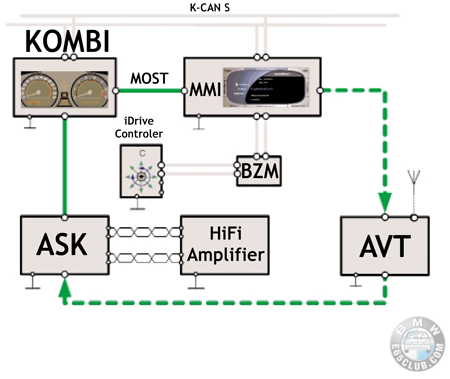
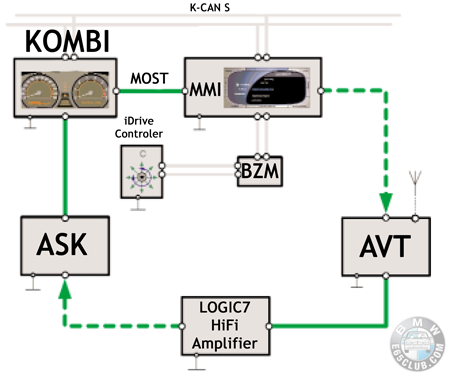
Components
Antenna/Radio Tuner with Diversity (AVT)
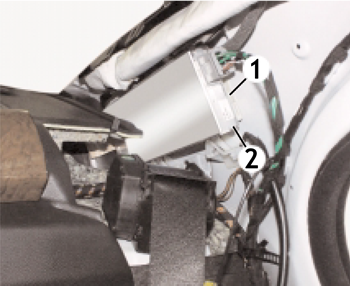 The E65 tuner is different from previous radios. The tuner is actually a control unit with a MOST port and is placed in a different location than the radio.
The E65 tuner is different from previous radios. The tuner is actually a control unit with a MOST port and is placed in a different location than the radio.
The tuner (2) is now located close to the antennas. The installation location of the antenna tuner is in the rear left C pillar. Due to the direct connection of the antenna diversity (1), no antenna amplifier is needed on the left-hand side.
On the right-hand side, there is an antenna amplifier which is linked via a coaxial cable to the diversity unit. The tuner provides the power supply to the antenna diversity and the antenna amplifier.
The digital audio signals are transmitted to the ASK via the MOST, therefore there is no antenna coaxial cable. This avoids signal losses and interference.
The tuner used on U.S. E65s is a world tuner which can receive long wave (LW), medium wave (AM), short wave (SW) and frequency modulation (FM), as well as traffic and weather forecast information (US). In the U.S. weather forecast information is transmitted on 7 different frequencies 24 hours a day.
The single tuner is set for all country variants, with the exception of the ECE. It corresponds to the former Business Radio.
Antenna System
The antenna for radio and remote control services (FBD) on the E65 are located in the rear window. They include an AM antenna for LW, MW, and SW and 4 FM aerials for VHF reception. The FBD frequency for U.S. vehicles is 868.4MHz (This is Key Fob)
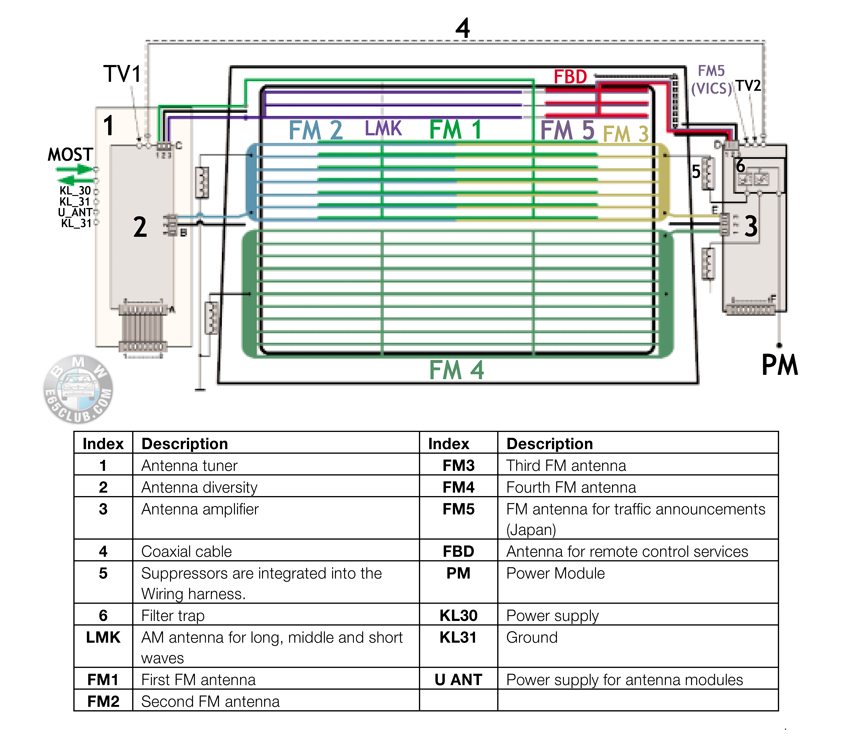
The antennas are switched by the diversity module, which is directly located on the tuner and is connected to it by an 8-pin ribbon cable.
The antennas for telephone and navigation are located in a separate shark fin antenna on the roof.
The advantages of the new E65 antenna system are the following:
• Powerful AM (LMK) antenna.
• FM diversity available in the basic audio system.
• High FM diversity performance due to 4 switchable antennas: FM 1-4.
• Modular application of basic system on many system variants, e.g. radio, TV, FBD.
• The antenna system (tuner) has diagnosis capability.
The antenna system is made up of the following components:
Rear Window
The rear window is made laminated safety glass (VSG) with infrared coating (IR).
The glass thickness is 4 mm. The antenna consist of leads 0.4 mm wide. The rear window is partitioned into three sections. The first part includes the AM and FM 5/FBD antennas.
The second part includes the FM 1, FM 2 and FM 3 antenna. The lower half includes the
FM 4 antenna.
The rear screen defroster uses the central and lower panels of the FM antenna. The heating power is approx. 300 W.
Antenna Diversity Unit (FM)
The antenna diversity is installed in the left C pillar, together with the tuner. It is connected to the tuner by an 8-pin ribbon cable.
The ribbon cable is used to transmit the operating voltage and the switching signals DIAGNOSIS, CONTROL, LEVEL, AUDIO from tuner to diversity. The HF signal is transferred from diversity to the tuner.
The antenna diversity is used to define the best antenna signal and controls the changeover and the output of the antenna signal on the HF output.
Antenna Amplifier (FM)
The antenna amplifier in the RH C-pillar is associated to antennas FM 3-4 and to the FBD antenna. The antenna amplifier is linked by a coaxial cable to the antenna diversity unit.
The FM antennas are switched over by a control signal, fed via the coaxial cable.
1. FBD antenna connection
2. Power input for the rear defroster
3. Rear defroster grid output connection
4. Antenna connection (FM1-FM5)
5. Connection for wiring harness (8-pin)
6. Antenna amplifier
7. Rear defroster grid output connection
8. Filter trap circuit for rear defroster
9. Coaxial connection to the antenna diversity unit
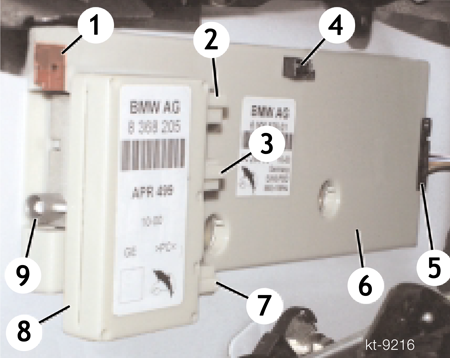
Antenna Amplifier (AM)
The AM amplifier used for LW, MW, and SW ranges, is located in the diversity unit in the LH C-pillar.
Audio System Controller
In the past, each system used its own output media (e.g. gong, dual cone speakers etc) which generated a number of different sounds in the car. It was often not possible to achieve coordination between these sounds or at best, it could be done only in particular cases.
This created situations where acoustic information for other sources had to be suppressed, otherwise the driver would have been faced with a confusing mix of acoustic signals.
On the E65, a control unit has been developed to control, coordinate and generate acoustic signals according to priority: the Audio System Controller, (ASK).
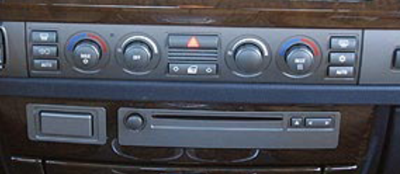
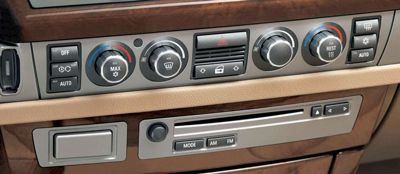
The Audio System Controller (ASK) has three main functions.
• Network master
• Audio master
• Connection master
Network Master
The ASK performs the role of network master for the MOST bus. The functions of the network master are the following:
- Wake-up, initialization, power-down
The network master wakes up the bus and has the task of achieving an orderly initialization of the network. The ASK can operate with KLR off. To turn it on, push in the volume/ON/OFF knob. Adjustments and control is carried out by using the Controller and Control Display.
Another task of the network master is to control the power-down process. Each powerdown is initiated and started by the ASK. - Configuration control
The network master detects the exact system configuration each time that the network is started and compares it to the stored coded configuration. - Control of the network operation
The network master controls the MOST transceiver of the slave equipment for correct operation. The equipment which is not operating properly will be released by a reset or switched to low power mode so that they do not affect bus communication. - Fault code memory
The network master includes the fault code memory of the MOST network. It stores all the faults occurring during the network operation as well as deviations from the nominal configuration.
- Wake-up, initialization, power-down
Audio Master
As audio master, the ASK has the task to collect and process all the audio signals of the vehicle and to distribute them to their destinations.
The ASK controls all the acoustic requests from the Control Display. The changes in the level of a signal is not sudden, but smooth, e.g. during suppression, insertion and fading out or temporary suppression of the signal at the destination: Because of this, a high-quality acoustic sound is obtained.
The ASK also assumes the generation and preparation of different acoustic signals, e.g. PDC signals and warnings. In the event of a request for a warning or caution signal from a control unit, the ASK provides a clean acoustic change of the signals.
- Audio data
All audio data from any control unit are converted by the ASK into digital audio AF format at a sampling rate of 44.1 KHz. - Categorization of audio sources
All possible audio sources are divided into different groups according to priority. Warning signals have priority over any other audio source. Mixing of lower priority audio signals (e.g. navigation, radio) is possible. - Generation of acoustic gongs
These are acoustic alarm signals which help the driver perceive sounds according to a
system. The different sounds, requested by the different control units, (e.g. gongs, PDC,
etc.), must be generated only in association with a visual indication. These come from
the instrument cluster and the Control Display.
- Audio data
The following sounds can be generated in the ASK.
- Beeping for the PDC.
- Various Check Control and warning gongs.
Output of Audio Signals
The output of audio signals occurs under the following conditions:
- Two gong signals are never output simultaneously.
- It is possible to generate a maximum of 3 signals at the same time.
- If the input includes a fourth signal, the signal at the lowest priority is muted.
- When issuing the 3 higher priority signals, the entertainment source is suppressed (radio). If the entertainment source is a CD, it is stopped and switched off. When the CD is reactivated, it restarts from the point where it was stopped.
Examples of audio output:
Radio:
The radio plays in the background, the PDC is active and a navigation message is output.
If a gong request comes, the radio is muted and the gong is generated.
Telephone:
When the hands-free function is activated the loudspeakers are muted. Gongs are mixed as required according to their priority. The Speech Processing System is not active when the hands-free function is used.
Speech Processing System:
When the voice processing system is activated, a general mute suppresses the loudspeakers. Gongs are mixed as required according to their priority. The hands-free operation and the navigation messages interrupt the Speech Processing System.
Connection Master
As connection master, the ASK must provide channels to the equipment connected to the bus and distribute the audio signals on the outputs (loudspeakers).
The connection master also controls the basic Hi-Fi or the LOGIC 7 Hi-Fi amplifiers.
Basic Hi-Fi Amplifier
A hi-fi system is offered as standard equipment and is characterized by vehicle-specific tuning to the interior (equalizing) with balanced acoustics.
The basic signals delivered by the ASK are amplified in the hi-fi amplifier equipped with bridge end stages. The output power is 40 W per channel. Total system output is 180 watts.
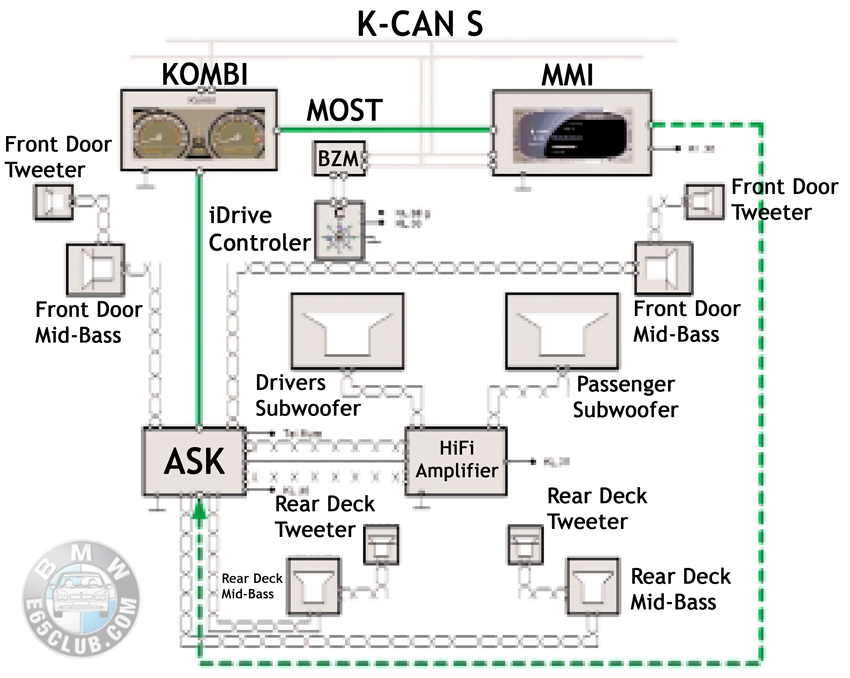
The hi-fi amplifier is controlled by the ASK. The medium-range loudspeakers and the tweeters are directly controlled by the ASK. The large sub-woofers underneath the driver and passenger seats are driven by the amplifier.
The hi-fi amplifier has no diagnosis capability.
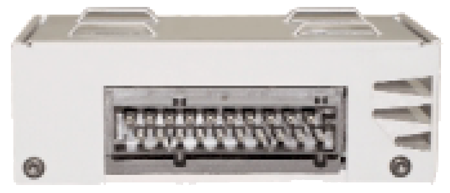
Hi-Fi Amplifier is located in the left rear of trunk just in front of Navigation and Changer Rack. You will have to remove the left trunk panel to gain access to it.
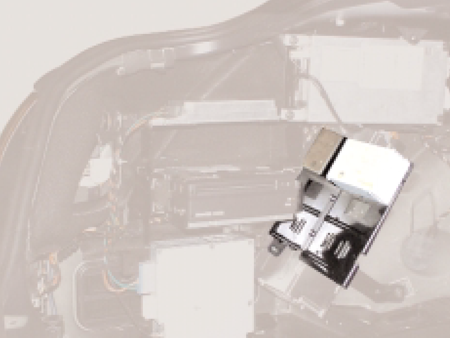
Logic 7 Hi-Fi Amplifier
To satisfy customers with the more demanding requirements for a low-distortion playback even at high levels and non-linear frequencies (e.g. amplified low frequencies), it is necessary to provide a sufficient output power to control the loudspeaker.
For these reasons, a LOGIC 7 hi-fi system with Surround Sound and 7-band equalizer was developed. The main differences from the hi-fi amplifier are the following:
- Active MOST bus components.
- Complete control via the software.
- Extended features versus the hi-fi system.
- Higher output power in the low-frequency range.
- More channels available to control additional loudspeakers.
- Diagnosis capability.
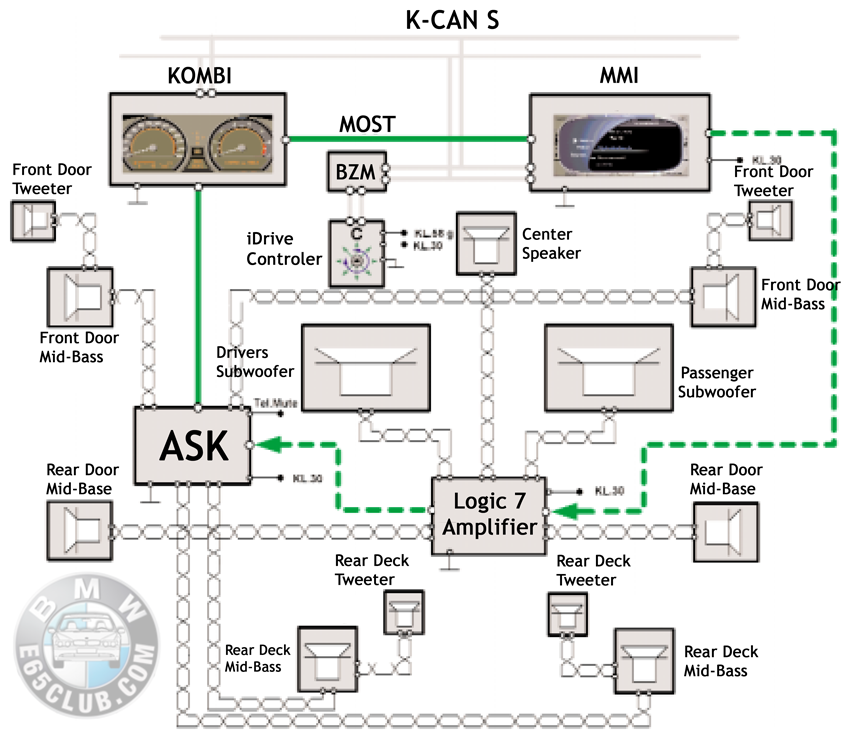
The LOGIC 7 hi-fi amplifier includes a MOST bus connection, to produce all audio and control signals in digital form. A digital / analog converter converts the audio signals and amplifies them in the final stages.
The output power of the mid-range loudspeaker is 40 W and the woofer is 70 W. Total system output is 420 watts.
Additional features are the central front loudspeaker in the instrument panel, the mid-range speakers in the rear doors and the tweeters under the rear shelf.
Besides the known functions like volume, fader, balance, treble, bass and GAL (speed-sensitive radio volume control) the two amplifiers hi-fi and LOGIC 7 hi-fi achieve the following functions:
- 7-band equalizer (LOGIC 7 hi-fi only)
The frequency ranges can be adjusted individually in the EQ menu in MMI. The adjustment is performed by the Controller and the Control Display on the ASK. - Surround Sound (LOGIC 7 hi-fi only)
Can be enabled / disabled by the Logic7 adjustment in MMI. Surround Sound is the use of at least 5 channels in the interior. With an additional loudspeaker in the front between the left and the right channel, a true spatial sound can be obtained.
- 7-band equalizer (LOGIC 7 hi-fi only)
The following functions cannot be controlled by the customer, but they are achieved in the amplifier software. (Some of these can be adjusted with NCS Expert, I am unclear as to what the “amplifier software” is.)
- Level adaptation
Switching between different audio sources (e.g. CC-CD) should produce no change in volume. For this purpose, all levels in ASK are processed on a standard level. - Loudness
To improve reception at a low-volume setting, the low frequencies are slightly amplified. (This can be turned on and off in NCS Expert, it usually just adds to distortion and I always recommend this left off.) - Vehicle-specific equalizing
Tuning of the acoustics according to the interior of the vehicle. - Speed-dependent equalizing (LOGIC 7-hi-fi only)
Adjustment of the acoustics to increasing noise emission from moving vehicles. - Dynamic compression
In a moving vehicle, the usable dynamics is limited in the upper range by the output power of the amplifier and the load characteristics of the loudspeaker. For this reason, a speed-dependent dynamics reduction must be performed. - Frequency-dependent delay (LOGIC 7 hi-fi only)
The frequency-dependent delay is used to introduce time corrections on the individual speaker units. This ensures that the audio signals are sent simultaneously to all speaker units.
- Level adaptation
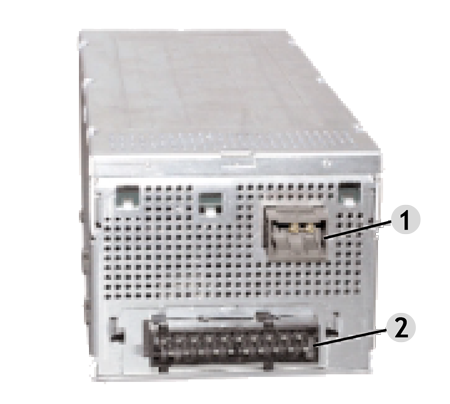

- MOST Connector
- 20 Pin Connector
Logic 7 Amplifier is located in left rear of trunk next to Changer and Navigation stack. You will need to remove the rear left trunk panel to access.
Speakers



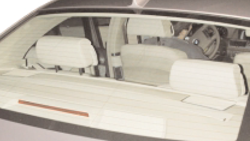
The Basic Hi-Fi of the E65 comes equipped with 10 speakers. If the LOGIC 7 system is ordered the vehicle has 13 speakers. The speaker locations are as follows:
- 100mm mid-range and 44mm high range speaker in each front door. Rear doors have mid-range speakers if equipped with LOGIC 7.
- 100mm center channel mid-range speaker located in the center of the instrument panel speaker if equipped with LOGIC 7.
- 210mm sub-woofers located underneath the driver and passenger seats.
- Two 100mm mid-range and two 44mm high-range speakers located in rear shelf.
CD Changer
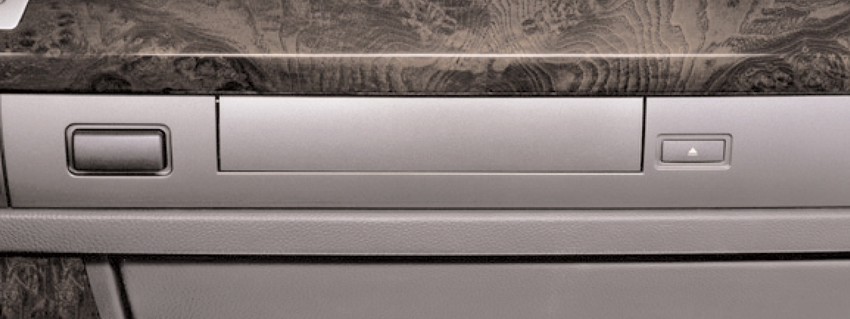
The audio CD changer on the E65 has the same features and mechanical structure as its equivalent in E38 / E39, it is produced by Alpine.
This is a 6-way-changer with magazine (1). It is installed on the passenger side in the instrument panel, behind a decorative strip. If you press the eject key and use the powered flap control, you can control the insertion and removal of the magazine from the driver and the passenger side.
A new feature of the CD changer is the optical connection to the MOST bus. The CD changer is controlled via the MOST bus interface and sends its digital audio signals over it.
The audio signals are sent to the ASK which transmits them via the amplifier and then to the loudspeakers.
To operate the CD changer, you can use the following options:
- Controller and Control display
- ASK and MFL
- Voice input
The CD changer has diagnostic capabilities in the Diagnosis Program via MOST.
